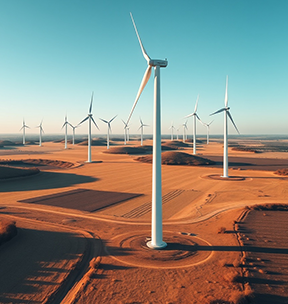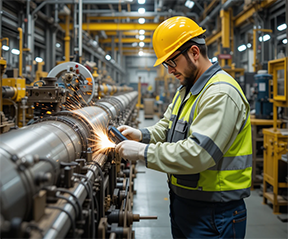Published: May 12, 2025 | Updated: October 22, 2025
Published: May 12, 2025 | Updated: October 22, 2025
Sustainable Maintenance Management Practices for Long-Term Success
 Over the last few decades, the industrial landscape has had to understand the significance of sustainable maintenance management practices. This approach goes beyond simply keeping equipment running. It focuses on resource consumption, extending asset life, and minimizing environmental impact, all while ensuring operational efficiency and financial viability.
Over the last few decades, the industrial landscape has had to understand the significance of sustainable maintenance management practices. This approach goes beyond simply keeping equipment running. It focuses on resource consumption, extending asset life, and minimizing environmental impact, all while ensuring operational efficiency and financial viability.
This article will delve into how to improve your maintenance by looking at ideas on how to succeed now and in the future.
Preserving Natural Resources Through Proactive Maintenance
One of the most compelling reasons for adopting sustainable maintenance practices is a positive impact on the environment. Traditional maintenance practices often involve excessive resource consumption. This leads to unnecessary waste and environmental degradation.
Imagine a manufacturing facility with hundreds of machines. Inefficient equipment can lead to energy overuse, water waste from cooling systems, and even raw material waste due to malfunctioning production lines.
Sustainable maintenance tackles this issue head-on. By implementing preventive maintenance strategies, organizations can identify and address potential problems before they escalate into major breakdowns. This proactive approach allows for:
- Energy Usage. Regular maintenance ensures equipment operates at peak efficiency. Thus, the assets consume less energy.
- For instance, regular inspections on an HVAC system in a commercial building keep the asset clean and operating at full capacity. It will use less power than one that is neglected.
- Resource Conservation. Preventive maintenance practices like lubrication and component cleaning extend the lifespan of equipment. Therefore, you reduce the need for frequent replacements and the associated raw material consumption.
- Further techniques include rainwater harvesting and greywater recycling. These practices can minimize reliance on municipal water supplies.
- Waste Reduction. Sustainable maintenance promotes practices like reusing spare parts and implementing proper disposal protocols for hazardous materials. This minimizes waste generation and associated environmental hazards.
Building a Positive Reputation Through Sustainable Maintenance
Sustainable maintenance doesn't just bode well for the environment. It affects a company's financial status.
Consider a facility manager overseeing a large office building. Without proper asset management, they might overstock on replacement parts. This unnecessarily increases inventory costs and potential obsolescence.
Similarly, reactive maintenance also results in more problems over time. This mindset means you only make repairs after breakdowns, risking safety and production. It also tends to increase expenses for emergency repairs and technician overtime. Adopt a preventive maintenance program instead.
A CMMS (Computerized Maintenance Management System) plays a pivotal role in sustainable maintenance. Let's look at some areas where CMMS software benefits.
Discover how streamlined maintenance processes can elevate production. Learn more.
Asset Management
Part of the goals you want include keeping those assets operating at a baseline level. In the CMMS, you create a record of your assets. You include as much relevant information as you need.
- Manufacturer.
- Cost
- Location.
- Date of purchase.
From there, you set up your maintenance tracking, such as equipment readings and depreciation. You also create your maintenance schedules. The CMMS keeps a record of what work you've done.
You've already started on proactive planning. Read on to see how this affects other areas such as inventory and preventive maintenance.
Inventory Management
Knowing what assets you have, you purchase the correct amount of spare parts and supplies. As mentioned before, you don't want to overstock or have too few parts.
Once again, you create a list of your inventory. The CMMS software tracks quantities and can assist you with a physical count when needed.
 Work Order Management
Work Order Management
Here, we move into the maintenance itself. Processing work requests and creating work orders. The CMMS helps by standardizing these.
With a work order, you have the needed information formatted the same every time. You have the necessary bill of materials (BOM). You have the type of maintenance, the priority, and the location of the job. This means more efficiency for the technician.
A CMMS tracks open and closed work orders. You assign the best-skilled workers for the job. You better understand resource allocation.
Earlier, we looked at the financial aspects as part of the significance of sustainable maintenance management practices. So, how does a CMMS bring in the value for the bottom line?
Reduced Energy Consumption
When you have your preventive maintenance planning done through the software, you have fewer incidents or issues. Fewer unplanned downtime periods. Fewer emergencies because you can more easily spot problems before they intensify. All of this means your assets operate better and lower your energy bills.
Extended Asset Lifespan
Reactive maintenance risks replacing assets before their time. Preventive maintenance (PM) extends the life of equipment, delaying the need for costly replacements.
Safety
With PMs in place, you catch safety problems more easily. You resolve the potential hazard before it costs you in more ways than financial.
Improved Inventory Management
Overstock means you have parts that don't move. Understocking means you have emergency purchases. With a CMMS, you find that balance.
Building a Positive Reputation and Ensuring Regulatory Compliance
Consumers and investors increasingly favor companies that demonstrate a commitment to sustainability. Sustainable maintenance practices contribute to a positive public image.
Compliance with Regulations
While we hear stories of companies "bucking the system" when it comes to regulations, note that some regulations exist to set safety standards. Some exist to aid environmental safety. Sustainable maintenance practices ensure organizations can meet these regulations. That way, they avoid fines and legal penalties.
Enhanced Brand Reputation
Consumers support companies that prioritize environmental responsibility. Sustainable maintenance demonstrates a commitment to environmental stewardship, boosting the brand image.
Attracting Socially Responsible Investors
Looking for investors? They look for companies that demonstrate social awareness. If you can show how your company has Sustainable practices, you might attract more customers and investors.
Industry Examples of Sustainable Maintenance Practices
Let's look at how sustainable maintenance works in various industries. Consider a wind turbine farm. A single non-functioning turbine can significantly impact energy generation. What would benefit asset performance?
First, look at the repetitive mentions of prevention. PMs include inspections, lubrication, and timely repairs. Schedule these turbine PMs on a CMMS calendar.
How would PMs improve Efficiency? Take an example of a properly serviced conveyor belt in a manufacturing plant. This ensures smooth material flow, maximizing production efficiency.
Further Benefits
Enhanced Customer Satisfaction. Consistent production allows organizations to meet customer demand and delivery schedules, leading to higher customer satisfaction.
Increased Profitability.Reduced downtime, improved efficiency, and lower maintenance costs contribute to increased profitability.
Prioritizing Health, Safety, and Resource Management
Sustainable maintenance practices go beyond environmental and financial benefits. They also contribute to a safer and healthier work environment. Imagine a factory with poorly maintained machinery. This can pose significant safety risks to workers, leading to potential accidents and injuries.
Don't just think about these practices for the short-term benefits. They enhance an organization's long-term goals and success. What happens if you encounter a shortage of resources? Sustainable practices stretch your materials farther.
Embracing the Circular Economy Through Sustainable Maintenance
The concept of sustainable maintenance aligns closely with the principles of the circular economy. The circular economy aims to minimize waste and maximize resource efficiency by promoting reuse, repair, and recycling. Sustainable maintenance practices contribute to the circular economy through:
- Asset Refurbishment and Remanufacturing. Instead of discarding equipment at the end of its life cycle, sustainable practices encourage refurbishment and remanufacturing. You receive extra value from your assets.
- Component Recycling. By recovering and recycling usable components from old equipment, organizations minimize waste generation and promote resource conservation.
For more information on the concepts of a circular economy, read an article by Nokia.
You really can't afford to not have sustainable maintenance management practices. With far-reaching benefits as described above, you gain so much success and help ensure resources stay available for years to come. By integrating these practices into their operations, organizations can:
- Conserve natural resources and minimize environmental impact.
- Achieve significant cost savings through optimized resource utilization and preventive maintenance.
- Ensure regulatory compliance and build a positive public image.
- Enhance asset performance, reliability, and overall productivity.
- Foster a safer and healthier work environment for employees.
- Build resilience and adaptability to navigate future challenges.
Using a CMMS gives you that extra bonus in sustainable practices. For a superior system, call Mapcon Technologies at 800-922-4336. Ask for a free demonstration. Discuss scalability and concurrent licensing for better maintenance management success.
FAQs
What is the main goal of sustainable maintenance management?
The main goal is to go beyond simply keeping equipment running by focusing on resource conservation, extending asset life, and minimizing environmental impact while maintaining efficiency.
How does a proactive maintenance approach contribute to energy conservation?
Regular inspections and preventive maintenance (PM) ensure equipment operates at peak efficiency, causing assets like HVAC systems to consume less energy than neglected ones.
What role does a CMMS (Computerized Maintenance Management System) play in sustainable asset management?
A CMMS helps by creating asset records, setting up maintenance schedules, and tracking work history, which are all vital for proactive planning and extending asset lifespan.
How does sustainable maintenance help a company's financial status?
It reduces energy consumption and the need for costly emergency repairs, extends the asset lifespan, and helps avoid fines by ensuring regulatory compliance.
What is the connection between sustainable maintenance and the circular economy?
Sustainable maintenance aligns with the circular economy by promoting asset refurbishment, remanufacturing, and component recycling instead of discarding equipment.
How does using a CMMS improve a company's inventory management for sustainability?
A CMMS helps find the right balance between overstocking and understocking spare parts and supplies, preventing waste from parts that don't move and the need for emergency purchases.
MAPCON CMMS software empowers you to plan and execute PM tasks flawlessly, thanks to its wealth of features and customizable options. Want to see it for yourself? Click the button below to get your FREE 30-day trial of MAPCON!
Try It FREE!